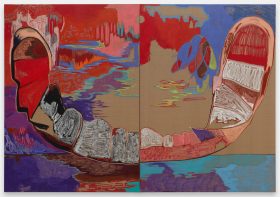“Memories are hunting horns whose sound dies on the wind.” So wrote Guillaume Apollinaire in 1912, in an effort to capture the transient quality of a remembered past. It is this same effort that nostalgia art serves today, making its presence felt by fulfilling our collective need to remember.
Earlier this year, the Brigham Young University Museum of Art in Utah held an exhibition called Nostalgia & Technology: Embracing the New through Art and Design that showcased both historical and more recent inventions, most of which have now become commonplace. One of the marketing strategies that the exhibition clearly revealed was the design of new inventions to resemble already familiar objects, so that the public would more easily accept them.
Similarly, The American Nostalgia Collection, which consists of art prints and posters that feature illustrations of popular 1950s American athletes, entertainers and automobiles, draws on people’s feelings of sentimental attachment to days gone by.
Subjects that evoke nostalgia are many and varied – the Chisholm Larsson Poster Gallery in New York City offers a catalogue of more than 30,000 original vintage posters from the 1890s to the present. These include Art Nouveau posters, posters by the acclaimed European poster artists Leonetto Cappiello and Adolphe Mouron Cassandre, posters depicting ocean liners, trains and airlines, political posters, and film and theatre posters.
The poster dates back to the nineteenth century and became the dominant means of mass communication in Europe and America from the 1870s onwards, reaching its peak in the 1890s, when French painter Toulouse-Lautrec’s first poster, Moulin Rouge, elevated the medium to the status of fine art. Moulin Rouge sold for $220,000 in 1989, the highest price ever paid for a fine art poster at an auction. Along with fine art posters such as Toulouse-Lautrec’s and those of other artists like Alphonse Mucha, Jules Cheret, Cassandre and Pierre Fix-Masseau, however, the market for niche categories such as travel, Olympics and war and propaganda has also been strengthening.
“Posters are a reminder of the past, mythical or otherwise,” Dr Rebecca Lewis told students and scholars at Oxford’s Ruskin College in 2000. “Any objects from the war are of interest, but the posters in particular reflect an idealised view of the past, containing selective, idealised ‘reality’ defining ‘this is how things should be/will be’. The idealized poster images presented are bound up with the general idealised mythology of the war.”
Another class of wartime posters approaches the war differently, portraying not an idealized view of wartime reality but “extremes of despair, anger and hope”, according to Cary Nelson, Jubilee Professor of Liberal Arts and Sciences and Professor of English at the University of Illinois. Images of death and anguish, he explains, also contain within them seeds of potential triumph, and this lends them power that transcends the depicted struggle.
The Spanish Civil War poster Criminales, besides being an example of wartime pain, is also “an allusion to Edvard Munch’s famous 1893 expressionist painting The Scream, Nelson says. Created by an unknown artist, Criminales illustrates a trait shared by much nostalgia art – the imitation of an existing style.
Borrowing styles has indeed made Vladimir Tretchikoff famous. The Russian-born South African artist, who died recently, shot to fame in the 1950s with his Chinese Girl, a print of a young woman with a bluish-green face and bright red lips that went on to sell more than half a million copies around the world. Dubbed ‘the Mona Lisa of kitsch’, Chinese Girl and other Tretchikoff prints such as The Dying Swan, Zulu Girl and Lost Orchid have experienced a revival in recent years, with prints fetching hundreds of dollars. Yet they remain reviled by critics.
Thomas Kinkade is another artist whose paintings speak of nostalgia for an idyllic past. Kinkade works such as Sunrise Chapel and Mountain Paradise portray scenes of pre-modern serenity, and he claims on his website to be ‘America’s most collected living artist’. He, too, has been labelled kitsch.
Jack Vettriano, Britain’s most popular artist, is suffering a similar fate. While over three million prints, posters and postcards based on his work have been sold, he is not represented in any of the nation’s major galleries. “There’s a snob association,” Vettriano told The Guardian. “When something’s too popular it’s regarded as a bit trashy.”
But Professor Duncan Macmillan of Edinburgh University repudiated this charge, saying, ‘The analogy in fiction would be Jilly Cooper, Mills & Boon or Harry Potter – should J. K. Rowling win the Booker Prize because she’s read by a lot of people? It’s interesting as a phenomenon: he’s obviously struck a popular note, but it cannot be translated directly into enduring quality.’
So is the distinction between high art and low art, kitsch and avant-garde simply to be explained by elitism and snobbishness, or is there a real quality gulf between these types of art? And how does nostalgia art fit into all of this?
“The fact is popular art dates,” said Stephen Sondheim, a contemporary American lyricist and composer. “It grows quaint. How many people feel strongly about Gilbert and Sullivan today compared to those who felt strongly in 1890?”
Yet the boundaries remain blurred. On the World of Kitsch website, Salvador Dali and Paul Klee are lumped together with Tretchikoff and Kinkade. Postmodernism has complicated things still more with its reintroduction of traditional elements of style and its approval of camp taste, which embraces kitsch with a new eye for its ironies. And while nostalgia art may bring Bing Crosby, Marilyn Monroe and Elvis Presley to mind, there are also instances of it which have immortalised sentiments that do not seem remotely entertaining or overdone.




